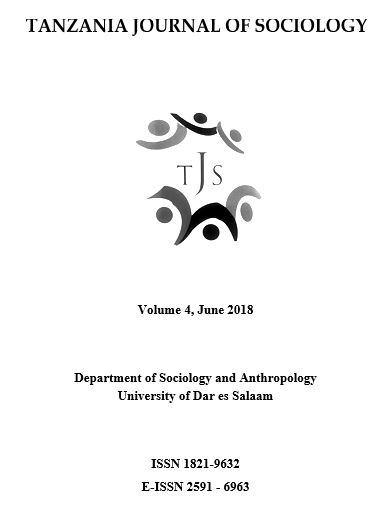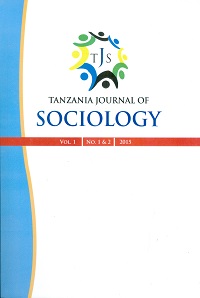Indigenous Institutions and Rangeland Sustainability in Northern Tanzania
Abstract
This study attempts to underscore the role of indigenous institutions on rangeland governance and sustainability among pastoral communities in northern Tanzania. Ostrom ' s institutional approach to governance of common-property rangeland resources is used as a conceptual framework to analyse indigenous institutional arrangement in relation to rangeland sustainability. Qualitative methodology is employed to capture narratives from indigenous people. A sample of 54 interviews and life histories as well as four focus group discussions from four research sites were obtained using a purposive sampling technique. There is strong evidence to substantiate that indigenous institutions play key roles as custodians of rangeland governance and are responsible for instituting norms and rules governing access and withdrawal of common-property resources and solving rangeland disputes. Therefore, Indigenous institutions should be recognized as an integral component of local resource governance. Furthermore, indigenous rangeland cooperatives should be formed to help preserve indigenous traditional institutions, which are crucial for sustainable rangeland governance.
Key words: Indigenous institutions, rangeland sustainability, pastoralism, common-property resources.
References
Anderson, D. M. 1995. Maasai: The People of Cattle. San Francisco: Chronicle Books. In Ronoh, A. K (2010) Effects of Murran System ' s Indigenous Knowledge on Maasai Youth ' s School Attendance in Narok District, Kenya (Pp. 1-23). African Research Review, an International Multi-Disciplinary Journal, Ethiopia Vol. 4 (3b) July, 2010.
Bahta, S. 2017. Promotion of Indigenous Knowledge through Scientific Research is Fundamental to Sustainable Development: An Anthropological Perspective. Department of Anthropology and Archaeology, Adi- Keih College of Arts and Social Sciences, Eritrea. Sociology and Anthropology 5(9): 776-780, 2017 http://www.hrpub.org.
Blaser, M. 2012. Ontology and Indigeneity: On Political Ontology of Heterogeneous Assemblages. Cultural Geographies published online October 2012.
Brokensha, D. et al., (eds.) 1980. Indigenous Knowledge Systems and Development, Lanham, University Press of America. In Lanzano, C. (2013) What Kind of Knowledge is Indigenous Knowledge? Critical Insights from a Case Study in Burkina Faso. Transience (2013) Vol. 4, Issue 2.
Bruyare B. L et al. 2016. A Comparison of Traditional Plant Knowledge between Students and Herders in Northern Kenya. Journal of Ethno-biology and Ethnomedicine. https://ethnobiomed.biomedcentral.com/articles/10.1186/s13002-016-0121-z accessed 6th April 2017.
Cavanagh, C. 2014. Biopolitics, Environmental Change, and Development Studies, Forum for Development Studies, 41:2, 273-294
Coast, E. 2001. Maasai Demography. PH.D. Thesis. LSE Research Online.
Coughenour, M. B., et al. 1985. "Energy Extraction and Use in a Nomadic Pastoral Ecosystem." Science 230: 619-25.
Ekaya W.N, (2005) The Shift From Mobile Pastoralism To Sedentary Crop-Livestock Farming In The Drylands Of Eastern Africa: Some Issues And Challenges For Research. African Crop Science Conference Proceedings, Vol. 7. pp. 1513-1519.
Ellis, J. and Swift, D. 1988. "Stability of African Pastoral Ecosystems: Alternate Paradigms and Implications for Development." Journal of Range Management 41(6): 450-59.
Fratkin, E. and Smith, K. 1995. Women ' s Changing Economic Roles with Pastoral Sedentarization: Varying strategies in alternative Rendille communities. Human Ecology, 23:433-454.
Fratkin, E. M. 2001. East African Pastoralism in Transition: Maasai, Boran, and Rendille. African Studies Review, Vol. 44, No. 3 (Dec., 2001), pp. 1-25.
Galaty, J.G. 2005. States of Violence: Ethnicity, Politics, and Pastoral Conflict in West Africa. Geography Research Forum, 25: 104-127.
Godana G. D et al. 2016. Pastoralists Perceptions on Factors Affecting Rangeland Productivity in Bayello Woreda, Southern Oromia, Ethiopia. World Journal of Pharmaceutical and Life Sciences, 2016, Vol. 2, Issue 2, 239-264.
Gosh P. K. and Sahoo, B. 2011. Indigenous Knowledge. Orissa Review, 2011.
Grant, P. 2016. State of the World ' s Minorities and Indigenous Peoples. Minority Rights Groups International, London.
Hardin, G. 1968. "The Tragedy of the Commons." Science, 162: 1243-48
Homewood, K. M. and Rodgers, A. 1990. Maasailand Ecology. Pastoralism and wildlife Conservation in the Ngorongoro Conservation Area, Tanzania. Cambridge University Press. Cambridge.
Humphries, K. E. 2012. A Political Ecology Of Community-Based Forest And Wildlife Management In Tanzania: Politics, Power and Governance: A Thesis Submitted to The University of Cambridge in Candidacy For The Degree of Doctor Of Philosophy.
ICOMOS and IUCN. 2012. Report on the Joint WHC/ICOMOS/IUCN Mission to Ngorongoro Conservation Area, Republic of Tanzania 10th -13th April 2012.
IFAD .2012a. Country Technical Note on Indigenous Peoples ' Issues. In Sirima, A. (2015) The Contribution of Indigenous Ecological Knowledge in Conservation of Enguserosambu Community Forest, Tanzania. Clemson University, Tiger Prints.
Kipuri, R. 1989. Maasai Women in Transition: Class and Gender in the Transformation of Pastoral Society. In Coast, E (2001) Maasai Demography. PH.D. Thesis. LSE Research Online.
Kiringe, J.W. 2006. A Survey of Traditional Health Remedies Used by the Maasai of Southern Kajiado District, Kenya. Ethno-botany Research and Applications, A Journal of Plants, People and Applied Research, p (61-74), 2006
Lanzano, C. 2013. What Kind of Knowledge is Indigenous Knowledge? Critical Insights from a Case Study in Burkina Faso. Transience (2013) Vol. 4, Issue 2.
Mapinduzi, et al. 2003. Use of indigenous ecological knowledge of the Maasai pastoralists for assessing rangeland biodiversity in Tanzania. African Journal of Ecology. Volume 41, Issue 4, December 2003, Pages 329 €“336
Monod, T. 1975. Introduction. Monod, T (ed) Pastoralism in Tropical Africa International African Institute. London: Oxford University Press. 8-98.
Mwangi, E and Ostrom, E. (2009) Top down Solutions: Looking up from East Africa ' s Rangeland. Environment, 51 (1): 35-44
Mwangi, M. 2016. Diverse Drought Spatiotemporal Trends, Diverse Etic-Emic Perceptions and Knowledge: Implications for Adaptive Capacity and Resource Management for Indigenous Maasai-Pastoralism in the Rangelands of Kenya. Climate, 2016, 4,22: 1-24.
Nakashima, D. 2017. UNESCO- Local and Indigenous Knowledge System Programme (LINKS). An indigenous People ' s Platform. Paris, France.
Ndagala, D.K. 1982. Commission on Nomadic Pastoralism. Operation Imparnati: The Sedentarization of Pastoral Maasai in Tanzania. Nomadic People, No. 10, April 1982
Nelson, F. et al. 2007. The Evolution and Reform of Tanzanian Wildlife Management. Conservation and Society, Pages 232 €“261 Volume 5, No. 2, 2007
Ngaido, T. n.d. Integrated Rangeland Management Systems. Range and Animal Science and Resource Management. Volume II. International Food Policy Institute, Washington D.C, USA
Niamir, M. 2010. Traditional African Range Management Techniques: Implications for Rangeland Development.
Oba, G (2012) Harnessing Pastoralists' Indigenous Knowledge for Rangeland Management: Three African Case Studies. Pastoralism: Research, Policy and Practice2012 2:1. Springer
Oba, G. and Kaitira L. M. 2005. Herder knowledge of landscape assessments in arid rangelands in northern Tanzania. Journal of Arid Environments 66: 168 €“186.
Olenasha, W. 2014. A World Heritage Site in the Ngorongoro Conservation Area: Whose World? Whose Heritage? In Disko, S and Tughedhat, H. (2014) World Heritage Sites and Indigenous People ' s Rights. IWGIA- Document 129, Copenhagen.
Ostrom, E. 1990. Governing the Commons: The Evolution of Institutions for Collective Action. The Political Economy of Institutions and Decisions. Cambridge University Press, London.
Ostrom, E. 2009. Beyond Markets and States: Polycentric Governance of Complex Economic Systems. Prize Lecture on December 08, 2009. Workshop in Political Theory and Policy Analysis, Indiana University, Bloomington, IN 47408, and Center for the Study of Institutional Diversity, Arizona State University, Tempe, AZ, U.S.A.
Potkanski, T. 1994. Livestock as Collective conflicting with Individual Property: Property Rights, Pastoral Economy and Mutual Assistance among the Ngorongoro/Salei Maasai of Tanzania, Ph.D. Dissertation, University of Warsaw, Warsaw.
Rahman A et al 2017. Indigenous knowledge management to enhance community resilience to tsunami risk: lessons learned from Smong traditions in Simeulue island, Indonesia
Rigby, P. 1985. Persistent Pastoralists: Nomadic Societies in Transition. 198 p. Zed Books. London.
Robbins, P. 2004. "Conservation and Control," in Political Ecology, pp. 147-172.
Ronoh, A. K. 2010. Effects of Murran System ' s Indigenous Knowledge on Maasai Youth ' s School Attendance in Narok District, Kenya (Pp. 1-23). African Research Review, an International Multi-Disciplinary Journal, Ethiopia Vol. 4 (3b) July, 2010.
Sirima, A. 2015. The Contribution of Indigenous Ecological Knowledge in Conservation of Enguserosambu Community Forest, Tanzania. Clemson University, Tiger Prints.
Talle, A. 1987. "Women as Heads of Houses. The Organization of Production and the Role of Women among Pastoral Maasai". Ethos 1-2: 50-80 in Coast, E (2001) Maasai Demography. PH.D. Thesis. LSE Research Online.
Tengo M et al. 2017. Weaving knowledge systems in IPBES, CBD and beyond lessons learned for sustainability. Current Opinion in Environmental Sustainability2017, 26 €“27:17 €“25. Available online at www.sciencedirect.com
UNEP .2008. Indigenous Knowledge and Disaster Management in Africa. Nairobi
UNESCO. 2015. Knowing our Lands and Resources: Indigenous and Local Knowledge of Biodiversity and Ecosystem Services in Africa. Task Force on Indigenous and Local Knowledge Systems, Intergovernmental Platform on Biodiversity and Ecosystem Services (IPBES), Paris.



